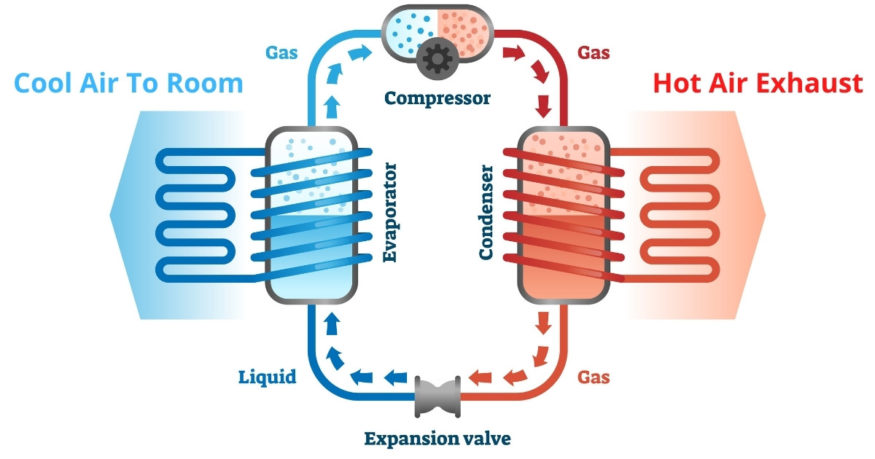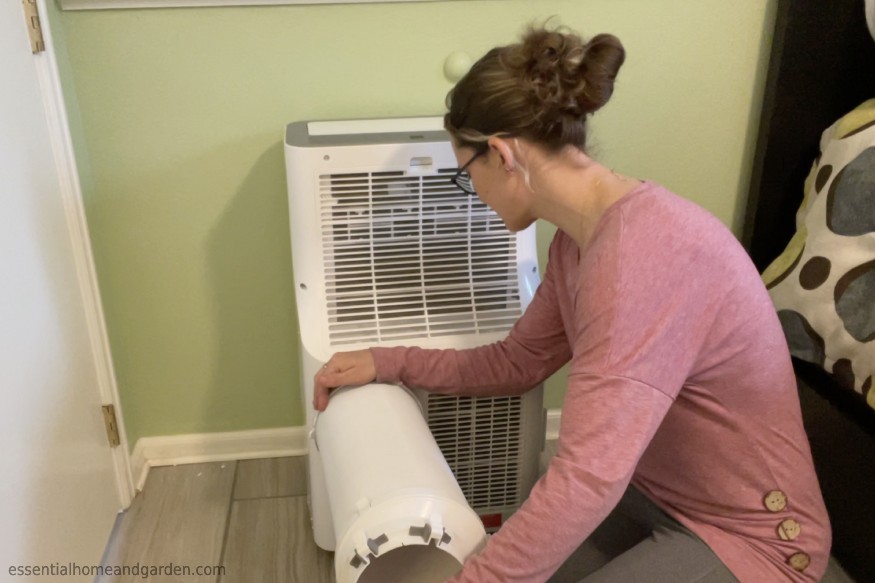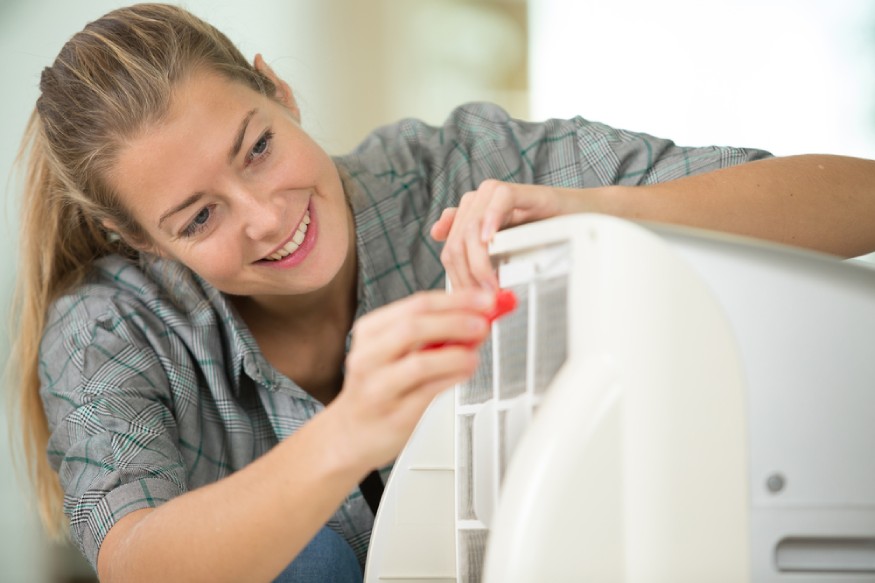Summer heat can be unbearable, and portable air conditioners are a great way to stay cool without breaking the bank. But how do they work?
It might not surprise you, but portable air conditioners work the same way as central air conditioning units and window AC units. However, they have a different form factor and sit on your floor next to a vent (usually through a window).
In this guide, we’ll take a look at how portable air conditioners work and some of their benefits. So, continue reading to learn about portable ACs.
How Does a Portable AC Work?

Portable air conditioners work by drawing in hot air from the room and passing it over a cold coil. This process cools the air, and the portable AC unit blows the cooled air back into the room.
Portable AC units use the vapor-compression refrigeration cycle to cool your room. This is exactly the same process a central air conditioner uses to cool an entire house. It’s just in a smaller, compact package.
Note: The portable AC unit contains refrigerant gas/liquid, a compressor, a condenser, evaporator coils, a blower, and a condensate collection system, all of which work together to transfer heat out of your house or apartment.
- The compressor pressurizes the refrigerant gas into a liquid where it travels to an expansion valve.
- Then, the expansion valve reduces the pressure, cooling the refrigerant before it enters the evaporator coils.
- The fan (or blower) moves hot air from your house over the evaporator coils and the air’s heat transfers to the refrigerant.
The now cold air blows into your room while the hot refrigerant travels to the condenser where another fan blows it out the exhaust pipe.
Proper Ventilation is Key to Working the Best
You must ventilate portable AC units for them to work correctly. Without proper ventilation, the unit will not be able to expel the hot air from the room, causing the unit to work less efficiently and possibly overheat.
Most floor air conditioners come with a window kit that includes an exhaust hose and window slider. The exhaust hose is used to vent the hot air outside, and the window slider helps to seal the opening.
To ensure proper ventilation, it is essential to follow the instructions that come with your portable AC unit.
Note: Improper ventilation can cause the unit to overheat and possibly break. In some cases, it can also be a fire hazard.
When using a portable air conditioner, it is vital to keep the following in mind:
- Make sure the area around the unit is clear and free of any obstructions.
- Do not use the unit in a confined space such as a closet.
- Do not place the unit on beds, sofas, or other pieces of furniture.
- Always follow the manufacturer’s instructions when using the unit.
Following these simple tips will ensure you are using your portable air conditioner safely and effectively.
Single Hose Vs Dual Hose Portable Air Conditioners

Most portable air conditioners have a single hose which exhausts hot air from the AC unit outdoors, typically through a window.
Single hose units constantly force air out of the room, creating a negative pressure. This causes air from other areas of your home and outside to force its way in through cracks in the doors, windows, etc.
Some portable air conditioners come with a dual hose system. In this type of system, one hose draws in air from outside to cool the compressor and condenser, and the other expels the hot air from the unit to the outside.
Note: Since dual hose air conditioners pull in air from the outdoors to cool internal components, they don’t generate a negative pressure like single hose units. This makes them more efficient.
Dual hose units also cool faster (and more efficiently) because they don’t have to work as hard to draw in air from the room. However, they can be more difficult to ventilate and may not be suitable for all types of windows.
When choosing a portable air conditioner, it is important to consider the size of the room and the type of window you have.
Single hose units are typically more suitable for smaller rooms, while dual hose units may be more appropriate for larger rooms or homes with multiple windows.
Whether you choose a single hose or dual hose portable air conditioner, proper ventilation is essential to ensure the unit works properly and doesn’t overheat.
What Maintenance Do Portable Air Conditioners Need?

Portable air conditioners are relatively low maintenance. The most important thing you can do is regularly clean the filter.
Most units have a reusable filter you can wash with soap and water. Some units also have a built-in dehumidifier, which can help to remove excess moisture from the air. If your unit has this feature, empty the water tank regularly.
Note: In addition to cleaning the filter, it is also important to keep the area around the unit clean and free of clutter. This will help ensure proper ventilation and allow the unit to work more efficiently.
When not in use, be sure to store your portable air conditioner in a cool, dry place. If you’re storing it over winter, keep it in an area that won’t get below freezing. Doing so, will help prolong the unit’s life and keep it working properly.
FAQs
Here are some frequently asked questions we get about portable air conditioning units.
Do all portable air conditioners have to be vented out a window?
All portable air conditioners have to be vented, but it doesn’t have to go out a window. For example, it can vent out of a door or a dryer vent.
Air conditioners are technically heat pumps, which means they transfer heat out of your home. If it is not vented, it won’t be able to expel the heat (and cool your room).
How do I vent a portable air conditioner without a window?
There are a few ways to vent a portable air conditioner without a window. One option is to use an air conditioner sleeve, which is a tube that goes from the exhaust hose to the floor. Another option is to create a makeshift window with PVC pipe and a tarp or install a dryer vent through an exterior wall.
Can You Extend the Exhaust Hose on a Portable Air Conditioner?
Yes, you can extend the exhaust hose on a portable air conditioner. This is often necessary when venting through a window that is further away from the unit. Portable air conditioner hoses typically come in lengths of 5 to 6 feet, but they can be extended up to 25 feet with special extension hoses.
Do You Have to Drain Water from a Portable Air Conditioner?
You will have to drain water from most portable AC units. All portable AC units dehumidify (it’s a byproduct of the cooling process), which means they will remove moisture from the air as they cool it. But if you live in a dry climate, you probably won’t have to deal with emptying tanks.
However, moisture collects in the portable air conditioner’s tank if the air is humid, and you will need to empty this tank regularly. Thankfully, some portable ACs have a continuous drain line that you can feed through your window or into a drain in your home.
Additionally, some portable AC units remove moisture through the exhaust vent with a new feature called self-evaporation.
Who repairs portable air conditioners?
HVAC technicians can repair some makes and models of portable air conditioners– to a certain extent. You can also do some light maintenance on your portable AC unit yourself. But most significant repairs have to go back to the manufacturer.
Do portable air conditioners actually work?
Yes, portable air conditioners work. Most people have felt the cool air a window AC unit brings to a room. A portable air conditioner is essentially the same thing; it is just a different shape and sits on your floor.
How long can I run my portable air conditioner?
Most units can run continuously for 24 hours. However, following the manufacturer’s instructions is vital to ensure the unit doesn’t overheat.
Can I use a portable air conditioner in a windowless room?
Yes, you can use a portable air conditioner in a room without a window. However, you’ll need to vent the unit to the outside. You can do this with an exhaust hose through an exterior wall (like a dryer vent) or an open door.
Conclusion
Portable air conditioners use the same technology as central air conditioners and window AC units but in a different form factor. They are an excellent option for cooling a single room or small space. They’re easy to set up, and you can move them from room to room as needed. Just be sure to vent the unit properly and keep it clean to ensure it works properly.